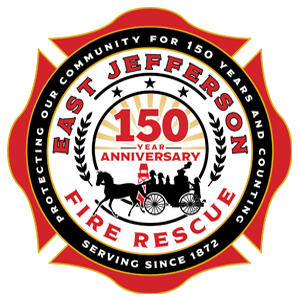Kala Point Area Fire Protection Class Modification
East Jefferson Fire Rescue (EJFR) is pleased to announce a Fire Protection Class (FPC) Modification in and around the Kala Point geographic area. In March 2019, EJFR proposed a FPC modification to the Washington Survey and Rating Bureau (WSRB) based on recent adjustments utilizing response volunteers and off-duty career firefighters that also reside within five road miles of Fire Station 1-3 (50 Airport Road). Approval and the subsequent FPC modification was effective April 1, 2019.
Inaccuracies in WSRB Ratings for Some Area Homes
Fire Chief Walkowski stressed that in order to obtain a corrected rating, area residents must take the initiative to contact the WSRB and if in error, their insurance provider. “This correction will not be initiated by the WSRB,” he said. “Residents are encouraged to contact them directly at their customer service telephone line at 206-217-0101. Specifically request you want to confirm the Fire Protection Classification of your insured structure and ask them to calculate the driving distance from your home to the nearest fire station.” Here is the News Release.
Washington State is one of a handful of states which utilize the services of an independent rating service to evaluate communities for their fire protection and suppression capabilities. Using a schedule approved by the Washington State Office of the Insurance Commissioner, they assign each community a Protection Class of 1 (exemplary) through 10 (insufficient for insurance credit). This Rating may be utilized by an insurance company to assist in determining fire insurance premiums for properties. However, not all insurance companies use the WSRB rating to set insurance rates. Communities are evaluated on a five-year frequency and evaluations include four major areas:
Fire Department: WSRB reviews such items as engine companies, ladder companies, distribution of fire stations and fire companies, automatic aid received, response to alarms, equipment carried on apparatus, apparatus maintenance, pumping capacity, reserve apparatus, department personnel levels and training.
Water Supply: Water supplies used are reviewed to determine their adequacy for fire-suppression purposes. Major tasks include calculating required fire flows (gallons per minute) for buildings and conducting flow tests to measure water pressures (psi) and volume (gpm). WSRB considers hydrant size, type, and installation, as well as the inspection frequency and condition of fire hydrants.
Emergency Communications Systems: The community’s 911 system is evaluated including facilities, handling and dispatching fire alarms, dispatch personnel levels and training.
Fire Safety Control: Fire prevention activities such as fire code enforcement, public education and building code enforcement are reviewed.
After completing the field survey, WSRB analyzes the data and calculates the Protection Class for the community. The community receives a notification letter identifying the Protection Class along with a summarizing report. Buildings and property located within the rated community are eligible for the Protection Class Rating of the community if they meet the distance to fire station and distance to fire hydrant requirements. If these requirements are not met the building will receive a different Protection Class Rating than the community.
After investing in apparatus, equipment and personnel training and enhancing our Fire Safety Control, Jefferson County Fire Protection District No. 1’s rating improved from a 6 to a 5 as a result of a 2013 evaluation.
However, changes resulted from our most recent evaluation, which took place in 2017 and became effective in early 2018. While our overall District-wide rating remained unchanged at a 5, deficiencies in two areas impacted improved properties (structures) within a five road-mile radius of our three volunteer fire stations.
As an overview, District 1 has a total of six fire stations, three of which are staffed 24/7:
Station 1-1 – The Wally Westergaard Station located at 9193 Rhody Drive, Chimacum
Station 1-5 – The Henry Miller Station located at 35 Critter Lane, Port Townsend
Station 1-6 – The Uptown station located at 701 Harrison St., Port Townsend
Our three volunteer response stations are:
Station 1-2 – The Marrowstone Island station located at 6633 Flagler Rd., Nordland
Station 1-3 – The Jefferson County International Airport station located at 50 Airport Rd.
Station 1-4 – The Cape George station located at 3850 Cape George Rd., Port Townsend
In the 2018 evaluation, District 1 received demerits for the age of our emergency response vehicles (apparatus), many of which we still owned after the prior evaluation five years earlier.
For the first time, we also received demerits for having an insufficient number of volunteer firefighters who regularly train and respond from our three volunteer stations. In order to receive credit for these stations, District 1 would need six volunteer firefighters to regularly train and respond from each station.
Currently, we have an insufficient number of volunteer firefighters, contributing to a rate reduction in some areas.
The District is focusing efforts on returning to our previous rate for all customers, but this will take time. As the District continues to modernize our apparatus fleet, this is only possible as our budget allows. In addition, the District is conducting numerous volunteer recruiting efforts, offering at least three times annually the ability for members of the community to join the volunteer ranks.
How can you help? Consider volunteering with the District. While we need a number of trained and active volunteer firefighters to improve our WSRB rating, we’re also looking for volunteers to assist us in a variety of capacities, including tender drivers, EMS responders and various support roles.
2017 WSRB Rating Letter
2018 WSRB Protection Class Report for JCFD #1



